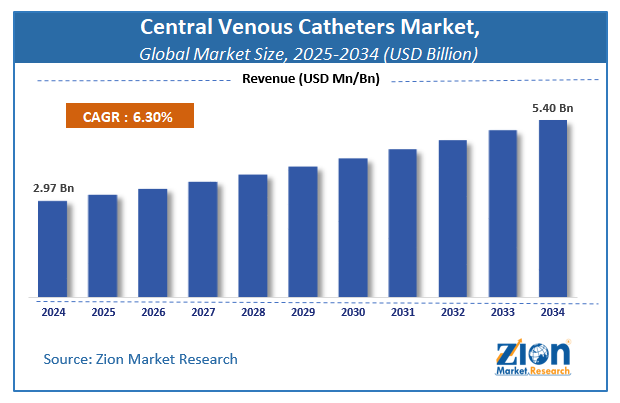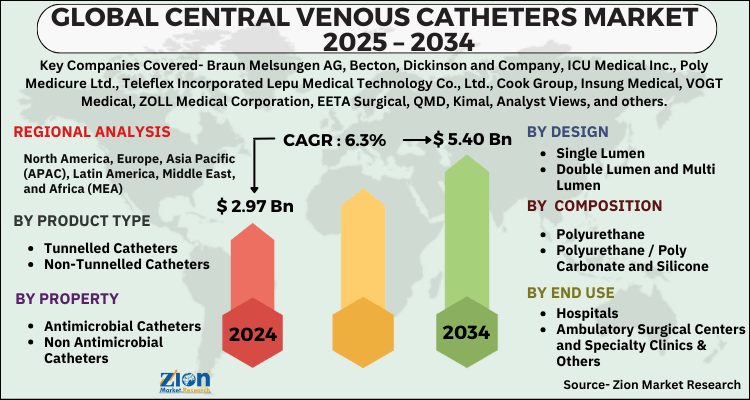Global Central Venous Catheters Market Size, Share, Growth Analysis Report - Forecast 2034

Central Venous Catheters Market By Product type (Tunnelled Catheters and Non-Tunnelled Catheters), By Property (Antimicrobial Catheters and Non Antimicrobial Catheters), Design (Single Lumen, Double Lumen and Multi Lumen), Composition (Polyurethane, Polyurethane / Poly Carbonate and Silicone), End Use (Hospitals, Ambulatory Surgical Centers and Specialty Clinics & Others), and By Region: Global and Regional Industry Overview, Market Intelligence, Comprehensive Analysis, Historical Data, and Forecasts 2025 - 2034
| Market Size in 2024 | Market Forecast in 2034 | CAGR (in %) | Base Year |
|---|---|---|---|
| USD 2.97 Billion | USD 5.40 Billion | 6.3% | 2024 |
Central Venous Catheters Industry Perspective:
The global central venous catheters market size was worth around USD 2.97 Billion in 2024 and is predicted to grow to around USD 5.40 Billion by 2034 with a compound annual growth rate (CAGR) of roughly 6.3% between 2025 and 2034. The report analyzes the global central venous catheters market's drivers, restraints/challenges, and the effect they have on the demands during the projection period. In addition, the report explores emerging opportunities in the central venous catheters industry.
The report analyzes the Central Venous Catheters market’s drivers, restraints/challenges, and the effect they have on the demands during the projection period. In addition, the report explores emerging opportunities in the Central Venous Catheters market.
Central Venous Catheters Market: Overview
In Central Venous Catheters Market Report, Central venous catheters, also known as central lines, central catheters, or central venous access devices, play a critical role in the treatment of a wide range of medical disorders. Catheters are small, flexible tubes that are placed into a big vein near a patient's heart. The other end of the gadget makes it easier to provide medications, fluids, and other substances.
In comparison to peripheral intravenous lines, central venous catheters are longer and larger in size. People who are undergoing cancer therapy may be prescribed these devices. Patients with difficult-to-find, frail, or damaged veins, as well as those whose arms are unsuitable for intravenous line use, might consider central venous catheters. The market for Central Venous Catheters is predicted to grow as major companies develop production facilities and participate in joint ventures to manufacture these devices.
The market is being driven by rising hospitalization rates and increased catheter adoption rates. Socioeconomic factors, such as the growing geriatric population and rising incidences of various chronic diseases, including malignant cancer, are also driving the market growth. These factors are driving the demand for antimicrobial-coated catheters. The increasing number of product developments is another important growth factor.
The increased development of tip location devices that enable precise placement or positioning of the central venous catheter has fueled rapid growth in the global central venous catheter market. The reimbursement status of central venous catheters is determined by the patient's age, product category, indication, and insertion process. Manufacturers of central venous catheters are putting more money into improving product quality and design in order to reduce hazards and ensure patient safety.
Key Insights
- As per the analysis shared by our research analyst, the global central venous catheters market is estimated to grow annually at a CAGR of around 6.3% over the forecast period (2025-2034).
- Regarding revenue, the global central venous catheters market size was valued at around USD 2.97 Billion in 2024 and is projected to reach USD 5.40 Billion by 2034.
- The central venous catheters market is projected to grow at a significant rate due to rising prevalence of chronic diseases, increasing demand for intravenous therapies, advancements in catheter technology, and the growing number of surgical procedures requiring vascular access.
- Based on Product type, the Tunnelled Catheters segment is expected to lead the global market.
- On the basis of Property, the Antimicrobial Catheters segment is growing at a high rate and will continue to dominate the global market.
- Based on the Design, the Single Lumen segment is projected to swipe the largest market share.
- By Composition, the Polyurethane segment is expected to dominate the global market.
- In terms of End Use, the Hospitals segment is anticipated to command the largest market share.
- Based on region, North America is predicted to dominate the global market during the forecast period.
Central Venous Catheters Market: Growth Drivers
Drivers:
The increasing number of cardiovascular and cancer patients, the aging population, and people suffering from a variety of chronic conditions are the primary growth drivers for the Central Venous Catheters Market.
Restraint:
In the projected period, risks such as central vein damage, pulmonary difficulties, cardiac complications, device malfunction, catheter-related bloodstream infection, and increased usage of other vascular access devices will restrain the market.
Challenges:
Patients on maintenance hemodialysis still rely on central venous catheters for access. For all stakeholders involved in CVCs, there are numerous critical and developing clinical and regulatory considerations. To help promote better output results for patients getting maintenance hemodialysis, innovation, transparency, and a thorough regulatory examination of these devices are required. A committee comprised of industry leaders and members from the US Food and Drug Administration was formed to identify the primary design considerations, clinical and regulatory issues, and clinical and regulatory challenges of CVC for hemodialysis.
Central Venous Catheters Market: Report Scope
| Report Attributes | Report Details |
|---|---|
| Report Name | Central Venous Catheters Market |
| Market Size in 2024 | USD 2.97 Billion |
| Market Forecast in 2034 | USD 5.40 Billion |
| Growth Rate | CAGR of 6.3% |
| Number of Pages | 188 |
| Key Companies Covered | Braun Melsungen AG, Becton, Dickinson and Company, ICU Medical Inc., Poly Medicure Ltd., Teleflex Incorporated Lepu Medical Technology Co., Ltd., Cook Group, Insung Medical, VOGT Medical, ZOLL Medical Corporation, EETA Surgical, QMD, Kimal, Analyst Views, and others. |
| Segments Covered | By Product type, By Property, By Design, By Composition, By End Use, and By Region |
| Regions Covered | North America, Europe, Asia Pacific (APAC), Latin America, The Middle East and Africa (MEA) |
| Base Year | 2024 |
| Historical Year | 2020 to 2024 |
| Forecast Year | 2025 to 2034 |
| Customization Scope | Avail customized purchase options to meet your exact research needs. Request For Customization |
Central Venous Catheters Market: Segmentation Analysis
The global central venous catheters market is segmented based on Product type, Property, Design, Composition, End Use, and region.
Based on Product type, the global central venous catheters market is divided into Tunnelled Catheters and Non-Tunnelled Catheters.
On the basis of Property, the global central venous catheters market is bifurcated into Antimicrobial Catheters and Non Antimicrobial Catheters.
By Design, the global central venous catheters market is split into Single Lumen, Double Lumen and Multi Lumen.
In terms of Composition, the global central venous catheters market is categorized into Polyurethane, Polyurethane / Poly Carbonate and Silicone.
By End Use, the global Central Venous Catheters market is divided into Hospitals, Ambulatory Surgical Centers and Specialty Clinics & Others.
Central Venous Catheters Market: Regional Landscape
North America is the main market for central venous catheters, accounting for a large portion of the market's revenue growth. The reasons for this are enhanced medical facilities and well-developed healthcare infrastructure, as well as rising cancer, cardiovascular, and end-stage renal disease rates and an aging population.
Over the projection period, the market in the Asia Pacific is predicted to develop at a faster rate due to an expanding patient pool, rising government initiatives to improve healthcare facilities and rising disposable income in various countries in the area.
Central Venous Catheters Market: Competitive Analysis
The report provides a company market share analysis to give a broader overview of the key market players. In addition, the report also covers key strategic developments of the market, including acquisitions & mergers, new product launches, agreements, partnerships, collaborations & joint ventures, research & development, and regional expansion of major participants involved in the central venous catheters market on a global and regional basis.
The global central venous catheters market is dominated by players like:
- Braun Melsungen AG
- Becton
- Dickinson and Company
- ICU Medical Inc.
- Poly Medicure Ltd.
- Teleflex Incorporated Lepu Medical Technology Co.
- Ltd.
- Cook Group
- Insung Medical
- VOGT Medical
- ZOLL Medical Corporation
- EETA Surgical
- QMD
- Kimal
- Analyst Views
The global central venous catheters market is segmented as follows;
By Product type
- Tunnelled Catheters
- Non-Tunnelled Catheters
By Property
- Antimicrobial Catheters
- Non Antimicrobial Catheters
By Design
- Single Lumen
- Double Lumen and Multi Lumen
By Composition
- Polyurethane
- Polyurethane / Poly Carbonate and Silicone
By End Use
- Hospitals
- Ambulatory Surgical Centers and Specialty Clinics & Others
By Region
- North America
- The U.S.
- Canada
- Mexico
- Europe
- France
- The UK
- Spain
- Germany
- Italy
- Rest of Europe
- Asia Pacific
- China
- Japan
- India
- Australia
- South Korea
- Rest of Asia Pacific
- The Middle East & Africa
- Saudi Arabia
- UAE
- Egypt
- Kuwait
- South Africa
- Rest of the Middle East & Africa
- Latin America
- Brazil
- Argentina
- Rest of Latin America
Table Of Content
Methodology
FrequentlyAsked Questions
The global central venous catheters market is expected to grow due to increasing number of surgical procedures, rising prevalence of chronic diseases, and growing demand for long-term intravenous therapies and nutritional support.
According to a study, the global central venous catheters market size was worth around USD 2.97 Billion in 2024 and is expected to reach USD 5.40 Billion by 2034.
The global central venous catheters market is expected to grow at a CAGR of 6.3% during the forecast period.
North America is expected to dominate the central venous catheters market over the forecast period.
Leading players in the global central venous catheters market include Braun Melsungen AG, Becton, Dickinson and Company, ICU Medical Inc., Poly Medicure Ltd., Teleflex Incorporated Lepu Medical Technology Co., Ltd., Cook Group, Insung Medical, VOGT Medical, ZOLL Medical Corporation, EETA Surgical, QMD, Kimal, Analyst Views, among others.
The report explores crucial aspects of the central venous catheters market, including a detailed discussion of existing growth factors and restraints, while also examining future growth opportunities and challenges that impact the market.
RelatedNews
HappyClients
Zion Market Research
Tel: +1 (302) 444-0166
USA/Canada Toll Free No.+1 (855) 465-4651
3rd Floor,
Mrunal Paradise, Opp Maharaja Hotel,
Pimple Gurav, Pune 411061,
Maharashtra, India
Phone No +91 7768 006 007, +91 7768 006 008
US OFFICE NO +1 (302) 444-0166
US/CAN TOLL FREE +1 (855) 465-4651
Email: sales@zionmarketresearch.com
We have secured system to process your transaction.
Our support available to help you 24 hours a day, five days a week.
Monday - Friday: 9AM - 6PM
Saturday - Sunday: Closed






